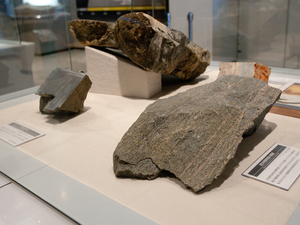Nagoya City Science Museum
TOP > Exhibition Guide > Floor Map> Old Rocks
Old Rocks



Purpose of Exhibition
We recommend that you touch it with your bare hand(s) to imagine the sights on the nascent Earth.
Additional Knowledge
Komatiite
Komatiite is a very rare igneous rock, characterized by a "spinifex" texture which is defined by extremely acicular olivine. The name of the rock comes from a locality on the Komati River in South Africa and of the texture from the shape of the spiky spinifex grass (Triodia species) seen in sand deserts in Australia. The unique texture of the rock is probably the result of the rapid cooling of very hot magma. Conditions for the formation of this lava (>1650C) only existed when the Earth was much younger and hotter, probably more than three billion years ago.
Ancient Earth's RocksWith a diminishing number of meteorites hitting the Earth, thus gradually causing lower temperatures, the vapor turned into rain water. Presumably, torrential rains continued to fall for as long as tens of thousands of years. The rains cooled down the Earth's surface and lowered the temperature, which caused further torrential rains. The rain water stayed in the sinkholes at or near the Earth's surface, and such sinkholes eventually formed into the oceans. However, the Earth then remained hot. The rock called "Kamatiite" evidences the fact. If you take a good look at it, you will find it to consist of capillary crystals. Those crystals are mostly olivines. But those crystals occur only when high-temperature magmas of 1,650 degrees or more rapidly cool down. In other words, the rock evidences that the Earth then was hot. The world's oldest rock is the Acasta gneiss, which was found in northwest Canada and is about 3.9 billion years old. The Amitsoq gneiss, which was found in Greenland, is approximately 3.8 billion years old and is deemed as one of the oldest rocks. Although submitted to anamorphism, the Amitsoq gneiss has the same composition as granite. Granite is the continent-forming rock. This means that the continents had already been formed billions years ago.
Cooperetion:
Exhibited by Earth's History Museum of Tokyo Institute of Technology
Article by Shoji Nishimoto, curator
